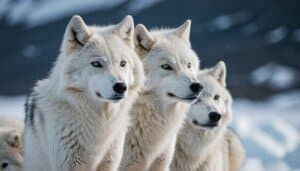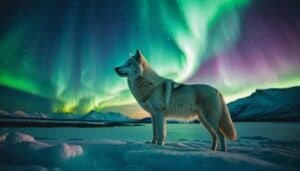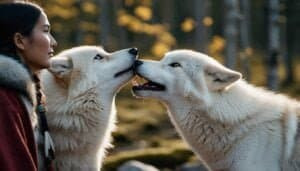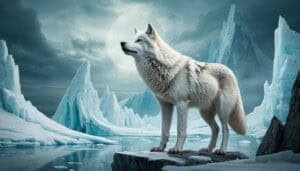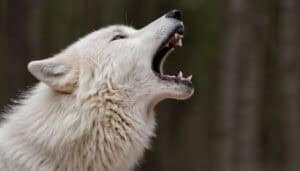Introduction
Arctic wolf pelts hold a significant place in the spiritual ceremonies of Arctic Indigenous peoples, symbolizing protection, guidance, and connection to the spirit world
These pelts are often used by shamans and community leaders to channel spiritual energy, represent guardianship, and honor the wolf’s role in maintaining balance within the ecosystem
This article explores the ceremonial use of Arctic wolf pelts, including their preparation, ethical considerations, and how these traditions are preserved and adapted in modern times
The Role of Arctic Wolf Pelts in Spiritual Practices
Arctic wolf pelts are deeply symbolic in the spiritual ceremonies of Arctic Indigenous peoples. Revered for their connection to the wolf’s strength, resilience, and spiritual presence, these pelts are integral to rituals that seek guidance, protection, or harmony with the natural and spiritual realms
Their use reflects a profound respect for the wolf and its role in the Arctic ecosystem
Symbolism of Wolf Pelts in Ceremonies
In many Arctic Indigenous cultures, the wolf is seen as a guardian and a bridge between the physical and spiritual worlds
Wearing or using wolf pelts in ceremonies symbolizes the wearer’s connection to these realms, invoking the wolf’s qualities of strength, wisdom, and protection. Shamans and spiritual leaders often wear wolf pelts to channel these energies during rituals
Walker (2021) noted that wolf pelts are sometimes seen as a spiritual armor, protecting the wearer from negative energies or malevolent spirits. In this way, the pelts represent both a physical and metaphysical shield, helping participants achieve balance and focus during ceremonies
The use of wolf pelts can also signify a leader’s role within the community. In some traditions, the pelt of an Arctic wolf is reserved for those with significant spiritual authority or responsibility, emphasizing their connection to the guardian spirit of the wolf
Preparation and Use of Pelts in Rituals
The preparation of wolf pelts for ceremonial use is often accompanied by rituals and prayers that honor the animal’s spirit
These practices ensure that the wolf’s essence is preserved and respected. The pelt is carefully cleaned and treated, often using traditional methods passed down through generations
Reed (2019) highlighted that specific markings or characteristics of a pelt may influence its ceremonial role. For example, a pelt with a distinctive pattern or color might be chosen for rituals seeking clarity or transformation
Once prepared, the pelt may be worn as a cloak, draped over ceremonial tools, or placed on altars as an offering to the spirit world
The Connection Between Wolf Pelts and Spirit World
Arctic wolf pelts are believed to act as conduits for spiritual communication. Shamans often use them during vision quests, healing ceremonies, or community blessings to channel the wolf’s energy and connect with the spirit world
The presence of the pelt in these rituals is thought to amplify the shaman’s ability to navigate between realms and seek guidance or protection for their community
Johnson and Hanson (2020) documented instances where participants in ceremonies reported feeling a heightened sense of connection to the wolf’s spirit when the pelt was present. This connection reinforces the belief that wolves are not only physical beings but also spiritual guardians deeply intertwined with human life in the Arctic
Through their symbolism, preparation, and use, Arctic wolf pelts embody the deep spiritual relationship between Indigenous peoples and the natural world. They serve as powerful reminders of the respect and reverence Arctic cultures have for the wolves that share their land
Ethical and Sustainable Use of Arctic Wolf Pelts
The use of Arctic wolf pelts in spiritual ceremonies reflects not only a cultural and spiritual connection but also a commitment to ethical and sustainable practices
Arctic Indigenous peoples have long recognized the importance of balance in nature, ensuring that their traditions respect the animals they honor and the ecosystems they inhabit
Indigenous Perspectives on Respecting Wolves
For many Arctic Indigenous cultures, the use of wolf pelts in ceremonies is deeply rooted in respect for the wolf as a sacred being
The act of taking a wolf for its pelt is accompanied by rituals and prayers that express gratitude and acknowledge the animal’s sacrifice. This ensures that the wolf’s spirit is honored and that its energy remains present in the community
Walker (2021) emphasized that wolves are never hunted indiscriminately. Instead, their selection is guided by traditional knowledge and spiritual practices
Elders and hunters often decide when and how a wolf should be taken, ensuring that the act aligns with cultural beliefs and the health of local wolf populations
Traditional Practices for Acquiring Pelts
Traditional methods of acquiring wolf pelts focus on sustainability and the preservation of both the animal and its habitat. Hunters rely on tracking techniques and an intimate understanding of wolf behavior to ensure that the hunt is respectful and efficient
Specific wolves may be chosen based on their age, health, or role within their pack, ensuring that the population remains stable
Once a wolf is taken, every part of the animal is used, reflecting the Indigenous principle of minimizing waste. The pelt is prepared using time-honored techniques that protect its integrity and enhance its ceremonial value. Tools, clothing, and even artwork may incorporate other parts of the animal, ensuring that its life is honored in multiple ways
Reed (2019) highlighted that such practices demonstrate a commitment to balance and sustainability, reinforcing the belief that humans are stewards of the natural world rather than its dominators
Balancing Cultural Traditions and Conservation
In the face of modern environmental challenges, including climate change and habitat loss, Indigenous communities are working to balance their traditions with conservation efforts. The ethical use of wolf pelts in ceremonies is increasingly paired with initiatives to protect wolf populations and their ecosystems
Johnson and Hanson (2020) noted that some communities have adapted their practices to reduce the need for pelts, using symbolic representations or replicas in certain ceremonies. These adaptations allow traditions to continue while addressing concerns about declining wolf populations in specific areas
Collaborative conservation programs that incorporate Indigenous knowledge are also helping to ensure the sustainability of wolf populations. These programs recognize the cultural importance of wolves while promoting practices that protect their long-term survival
By blending respect for tradition with a commitment to sustainability, Arctic Indigenous peoples ensure that their spiritual practices remain aligned with the principles of balance and harmony that define their relationship with the natural world
Modern Adaptations of Ceremonial Practices
As Arctic Indigenous communities adapt to modern challenges, their spiritual ceremonies involving Arctic wolf pelts have evolved
These adaptations allow traditions to remain relevant while addressing environmental, cultural, and ethical concerns. By blending traditional beliefs with contemporary practices, communities are finding ways to honor their heritage and ensure its continuity for future generations
The Continued Use of Wolf Pelts in Spiritual Ceremonies
Despite modern pressures, Arctic wolf pelts continue to hold a revered place in spiritual ceremonies. Their use reflects a commitment to maintaining cultural identity and a deep connection to ancestral traditions
In some communities, the use of pelts has been carefully adapted to align with conservation efforts, ensuring that ceremonies do not contribute to population declines or ecological imbalances
Walker (2020) highlighted that elders play a crucial role in guiding the ceremonial use of wolf pelts, ensuring that practices respect both the spiritual significance of the wolf and the need to protect its habitat
This guidance ensures that younger generations understand the importance of balance between cultural preservation and environmental stewardship
Integrating Traditional Beliefs in Contemporary Rituals
Modern adaptations of wolf symbolism often incorporate alternative materials or representations to preserve cultural traditions without relying on real pelts
For example, some communities use symbolic wolf imagery, such as artwork, carvings, or textiles, in place of pelts during ceremonies. These representations maintain the spiritual connection to the wolf while reducing the need to harvest pelts
Reed (2019) observed that these adaptations have also led to innovations in ceremony design, blending traditional practices with modern environmental advocacy
For instance, ceremonies invoking the wolf’s guidance may include activities such as habitat restoration or educational initiatives, emphasizing the continued relevance of the wolf as a guardian spirit
Educating Future Generations About Cultural Significance
Preserving the cultural significance of Arctic wolf pelts requires engaging younger generations in the stories, values, and practices associated with these ceremonies
Elders and cultural leaders are working to ensure that knowledge about the spiritual role of wolves is passed down, fostering a sense of pride and responsibility among youth
Green (2022) noted that storytelling, community workshops, and cultural events are effective ways to teach younger generations about the spiritual importance of wolves. These activities often emphasize the interconnectedness of nature and culture, encouraging youth to view themselves as stewards of both their traditions and the Arctic environment
Additionally, collaborations between Indigenous communities and schools or organizations have helped bring traditional knowledge into broader educational contexts. These partnerships not only preserve cultural practices but also raise awareness about the challenges facing Arctic wolves and their ecosystems
Through these modern adaptations, Arctic Indigenous communities are ensuring that the spiritual and cultural significance of Arctic wolf pelts remains alive, relevant, and sustainable. By blending tradition with innovation, they honor their heritage while addressing the realities of a changing world
Conclusion
The use of Arctic wolf pelts in spiritual ceremonies reflects the deep respect Arctic Indigenous peoples hold for these animals as guardians, guides, and symbols of resilience. These pelts play a central role in connecting humans to the spiritual world, protecting participants during rituals, and embodying the qualities of strength and unity
As modern challenges like climate change and habitat loss threaten wolf populations, Indigenous communities have adapted their practices to balance cultural preservation with ecological sustainability
By incorporating alternative representations and emphasizing conservation, they ensure that their traditions remain vibrant while safeguarding the natural world
Through storytelling, education, and collaboration, Arctic Indigenous peoples are preserving the spiritual significance of Arctic wolves for future generations
Their practices not only honor the wolves but also inspire broader efforts to live harmoniously with the environment, reflecting the interconnectedness of all life in the Arctic



